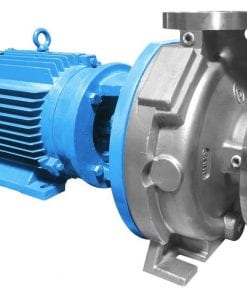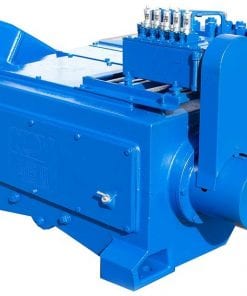Equipment Name: GE 752 DC Shunt Motor (Used)
Equipment Location: India
GE 752 DC Shunt Information
Manufacturer: General Electric
Model: GE752
Type of Motor: Shunt
Rated HP: 1000HP
Rated Voltage: 750 V DC
Rated Current: 1185 Amps
RPM: 1040rpm
Bearing Drive End: 558830C
Bearing Non Drive End: 558320C
GE 752 DC Shunt Motor Operation
Standard Torque Horizontal DC Drilling Motor, single shaft, shunt wound, left hand leads facing non-drive end. Thousands of original GE 752 DC Shunt Motors are performing worldwide on all types of drill rigs, providing dependable operations of the rig’s primary equipment. The GE 752 DC Shunt Motor have been reported by rig operators to run for years without service or failure.
GE 752 DC Shunt Motor operate on direct current. As such, the field windings and armature are connected in a parallel combination, and in electrical terminology a parallel combination is known as a shunt. This type of motor is a “shunt-wound” DC Motor and the type of winding is called a shunt winding.
In electrical terminology, a parallel circuit is often referred to as a shunt. Hence, DC motors in which the armature and field windings are connected in parallel are referred to as DC shunt motors. The variations in construction between series-wound DC motors and DC shunt motors result in some differences in operation between the two types, but the most significant difference lies in their speed characteristics. Where a series-wound DC motor exhibits a direct, inverse relationship between load and speed, a DC shunt motor is able to maintain a constant speed, regardless of the load on the motor.
When electric voltage is supplied to the GE 752 DC Shunt Motor, due to high resistance of the shunt winding, it draws very low current. The higher number of turns of the shunt winding helps in generating a strong magnetic field. The armature draws high current, thus also generating a high magnetic field. The motor starts rotating as the magnetic field of the armature and shunt winding interact. As the magnetic fields grow stronger, rotational torque will increase, thus resulting in an increase of rotational speed of the motor.
GE 752 DC Shunt Motor Advantages
- A GE 752 DC Shunt Motor has its armature and field in parallel or it may have separate field and armature supplies. In either case, this type of motor has good speed regulation (5% to 10%) and is capable of delivering 300 percent of its full load torque for a very short period of time.
- Lower price than a brand new motor
GE 752 DC Shunt Motor Speed Control
One can control the speed of a DC shunt motor in two ways:
- By varying the current supplied to the stator
- By varying the current supplied to the rotor
As the voltage around the rotor and stator is the same, the speed of the motor can be controlled by controlling the current through the stator or rotor. The current through the stator and rotor branches can be controlled by varying their resistance or by using a silicon controlled rectifier. The resistance can be increased in the shunt winding and armature branch by placing a rheostat in series. As the armature handles much higher current than the field winding, so the rheostat for controlling current in the armature branch is quite large. This is why having the current controlling rheostat in the field winding is generally preferred.
Shunt field current can change the speed of the motor by 10-20%. As the current through the shunt winding increases, the speed of the rotor increases, thus yielding higher back EMF to maintain the equivalent decrease in current of armature. Conversely, by decreasing the current through the shunt winding, the speed of the motor can be decreased.
Speed of the GE 752 DC Shunt Motor also decreases when the motor is operated at lower voltage than its rated voltage, but this makes it inefficient with a tendency to become overburdened and overheat. Generally, motors come with a specified rated speed in RPM and rated voltage. When a shunt DC motor functions below its full voltage, its torque is reduced. For these reasons, it is recommended not to operate the motor below its specified voltage rating.
Every motor or engine is different and there may be different requirements. For example, some motors may have a Full-Load test performed based on their specific application or request from customer.

![GE 752 DC Shunt Motor Used [AE] GE 752 DC Shunt Motor](https://www.flowtechenergy.com/wp-content/uploads/4-used-GE-752-motor-for-sale-20180822_162802_resized.jpg)
![GE 752 DC Shunt Motor Used [AE] (4) used GE 752 motor for sale-20180822_162705_resized](https://www.flowtechenergy.com/wp-content/uploads/4-used-GE-752-motor-for-sale-20180822_162705_resized.jpg)
![GE 752 DC Shunt Motor Used [AE] (4) used GE 752 motor for sale-20180822_162727_resized](https://www.flowtechenergy.com/wp-content/uploads/4-used-GE-752-motor-for-sale-20180822_162727_resized.jpg)
![GE 752 DC Shunt Motor Used [AE] (4) used GE 752 motor for sale-20180822_162812_resized](https://www.flowtechenergy.com/wp-content/uploads/4-used-GE-752-motor-for-sale-20180822_162812_resized.jpg)

![GE 752 DC Shunt Motor Used [AE] (4) used GE 752 motor for sale-20180822_162705_resized](https://www.flowtechenergy.com/wp-content/uploads/4-used-GE-752-motor-for-sale-20180822_162705_resized-247x296.jpg)
![GE 752 DC Shunt Motor Used [AE] (4) used GE 752 motor for sale-20180822_162727_resized](https://www.flowtechenergy.com/wp-content/uploads/4-used-GE-752-motor-for-sale-20180822_162727_resized-247x296.jpg)
![GE 752 DC Shunt Motor Used [AE] (4) used GE 752 motor for sale-20180822_162812_resized](https://www.flowtechenergy.com/wp-content/uploads/4-used-GE-752-motor-for-sale-20180822_162812_resized-247x296.jpg)
![NOV A1700PT Bearing New [AE] NOV A1700PT Bearing](https://www.flowtechenergy.com/wp-content/uploads/NOV-A1700PT-new-bearing-for-sale.-IMG-20180814-WA0004-100x100.jpg)
![NOV FC-1600 Triplex Mud Pump Used [AE] NOV FC-1600 Triplex Mud Pump](https://www.flowtechenergy.com/wp-content/uploads/20180915_151322_resized-1-100x100.jpg)


















